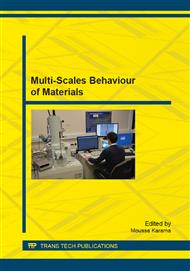[1]
C. Atzeni, F. Bodano, U. Sanna, N. Spanu, Surface strength: definition and testing by a sand impact method, Journal of Cultural Heritage, 7, p.201–205, (2006).
DOI: 10.1016/j.culher.2006.05.002
Google Scholar
[2]
A. Bernardi, F. Becherini, G. Bassato and M. Bellio, Condensation on ancient stained glass windows and efficiency of protective glazing systems, Journal of Cultural Heritage, 7, pp.71-78, (2006).
DOI: 10.1016/j.culher.2005.10.007
Google Scholar
[3]
N. Carmona, M.A. Villegas and J.M. Fernández Navarro, Study of glasses with grisailles from historic stained glass windows of the cathedral of León (Spain), Applied Surface Science, 252, pp.5936-5945, (2006).
DOI: 10.1016/j.apsusc.2005.08.023
Google Scholar
[4]
B.R. Lawn, Fracture of brittle solids. 2nd Edition, Cambridge University, UK, (1993).
Google Scholar
[5]
P.J. Slikkevver, P.C.P. Bouten, I. Veld, H. Scolten, Erosion and damage by sharp particles, Wear, 217, pp.237-250, (1998).
DOI: 10.1016/s0043-1648(98)00187-2
Google Scholar
[6]
J. E. Ritter, P. Strzepa, K. Jakus, L. Rosenfeld, K. J. Buckman, Erosion damage in glass and alumina, Journal American Ceramic Society, 67, pp.769-772, (1984).
DOI: 10.1111/j.1151-2916.1984.tb19515.x
Google Scholar
[7]
A.G. Evans, M.E. Gulden, M. Rosenblatt, Impact damage in brittle materials in the elastic-plastic response regime, Proc. R. Soc. London, Ser. A, 361, pp.343-345, (1978).
Google Scholar
[8]
T. Michalske, B. Bunker, La fracture du verre, Pour la science, pp.52-53, (1998).
Google Scholar
[9]
A. Franco, S.G. Roberts, The effect of impact angle on the erosion rate of polycristalline a-Al2O3 , Journal European Ceramic Society, 18, pp.269-270, (1998).
DOI: 10.1016/s0955-2219(97)00121-0
Google Scholar
[10]
S.M. Wiederhorn, B.J. Hockey, Effect of material parameters on the erosion resistance of brittle materials, Journal of Material Science, 18, pp.766-768, (1983).
DOI: 10.1007/bf00745575
Google Scholar
[11]
M. Buijs, Erosion of glass as modeled by indentation theory, Journal of the American Ceramic Society, 77, pp.1676-1678, (1994).
DOI: 10.1111/j.1151-2916.1994.tb09777.x
Google Scholar
[12]
J. Salomonson, D. Rowcliffe Journal American Ceramic Society, 78, pp.173-177, (1995).
Google Scholar
[13]
Y.I. Oka, M. Matsumura, T. Kawabata, Relation chip between surface hardness and erosion damage caused by solid particle impact, Wear 162-164, pp.688-695, (1993).
DOI: 10.1016/0043-1648(93)90067-v
Google Scholar
[14]
A.J. Sparks and I. M Hutchings, Wear 149, pp.99-110, (1991).
Google Scholar
[15]
S. Spinivasan, R.O. Scattergood, On lateral cracks in glass, Journal of material science, 22, pp.3463-3469, (1987).
Google Scholar
[16]
D.B. Marshall, Journal American Ceramic Society, 67, pp.57-60, (1984).
Google Scholar
[17]
A.W. Ruff, S.M. Wiederhorn, Treat. Mater. Sci. and Techn. 16, p.69, (1979).
Google Scholar
[18]
G.L. Sheldon and I. Finnie, J. Eng. Ind. 88, pp.387-392, (1966).
Google Scholar
[19]
S. Bouzid, N. Bouaouadja, Z. Azari, G. Pluvinage, Characterisation of Soda-Lime Glass Eroded by Simulated Sand Storm., 5th European Society on Glass Conference, (1999), Praha.
Google Scholar
[20]
D.M. Lloyd, E.A. Rogers, J.E. Oakey and A.J. Pittaway, Mat. Sci. Eng. 88, pp.295-01, (1987).
Google Scholar
[21]
A.W. Ruff and L.K. Ives, Measurement of solid particle velocity in erosive wear. Wear 35 p.195–199, (1975).
DOI: 10.1016/0043-1648(75)90154-4
Google Scholar
[22]
P. Chevalier, Thèse de Doctorat, Ecole centrale de Lyon, France (1994).
Google Scholar
[23]
S.R. Choi, J.A. Salem, Interaction of cracks between two adjacent indents in glass, Journal of Material Science, 28, pp.501-505, (1993).
DOI: 10.1007/bf00357830
Google Scholar
[24]
Goldsmith. W, Taylor.R. L, Experimental Mechanics, 16, pp.81-87, (1976).
Google Scholar
[25]
Y.I. Oka, M. Nishimura, K. Nagahashi, M. Matsumura, Wear, 250, pp.736-743, (2001).
Google Scholar
[26]
S. M. Wiederhorn, B.R. Lawn, Strength degradation of glass impacted with sharp particles: I. Annealed surfaces, Journal American Ceramic Society, 62, pp.67-70, (1979).
DOI: 10.1111/j.1151-2916.1979.tb18808.x
Google Scholar
[27]
J. Lemaitre, Micro-mechanics of crack initiation, International Journal of Fracture, 42, pp.87-88, (1990).
Google Scholar
[28]
K. Zeng, D. Rowcliffe, Experimental measurement of residual stress field around a sharp indentation in glass, Journal American Ceramic Society, 77, pp.524-530, (1994).
DOI: 10.1111/j.1151-2916.1994.tb07025.x
Google Scholar
[29]
A. Nyoungue; Z. Azari ; M. Abbadi; et al, Glass damage by impact spallation , Materials science and engineering a-structural materials properties microstructure and processing Volume: 407 Issue: 1-2, pp.256-264, ( 2005).
DOI: 10.1016/j.msea.2005.07.031
Google Scholar
[30]
J. Ismail, F. Zaïri, M. Naït-abdelaziz, S. Bouzid, Z. Azari Experimental and numerical investigations on erosion damage in glass by impact of small-sized particles, Wear, Issues 5-6, pages 817-826, (2011).
DOI: 10.1016/j.wear.2011.03.009
Google Scholar



